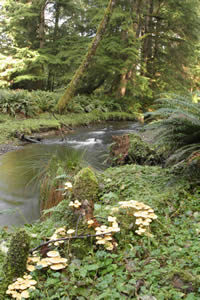
Ichthyologists and fisheries biologists tell us that anadromous fish species moving offshore recognize their “home” streams by tasting and smelling the unique mineral constituents flowing into the ocean at the stream sites of their birth. If I were placed blindfolded on the upper reaches of Elk Creek and its watershed area, I would know I was home. A distinct fusion of scents and textures of air emanates from the ground and understory beneath the ancient cedar and their arboreal associates: the sweet red alders, hemlocks, Sitka spruce, and vine maples. A clean, damp pungency rises from huckleberries (red and blue), sword fern, Oregon Grape, salal, assorted fungi, decaying wood, kinnikinnick, and elk droppings. The essences are ancient, a link and channel to our senses, a connection between the present and a time long gone by.
As a boy, I tramped the woods and stream bed with my pal, Gerry Sroufe, examining the natural world and sensing its rhythms: the time of band-tailed pigeons bolting in concert from snags below the watershed, the whistling call of bull elk in the rut, the dust drummings of grouse in summer alder thickets.
Our favorite haunt — the fishing holes below L. David Firebaugh’s water catch basin at the springs — stood at the end of Warren Road. On one occasion in the 50s we discovered an old two-man hand saw, a “misery whip,” crusted and rusty, in the streambed – a remnant of the first cutting of the old trees at the turn of the century. I remember our excitement at finding the relic. Hefting it sent a sense of adventure through our young vitals. By the 1960s The Van Vleet Logging Company had already skinned many of the surrounding areas, leaving in its wake clear-cuts and logging trash: wire ropes, rusted truck bodies, ramshackle powder shacks. The romance of early logging, if it ever existed, was gone.
Elk, or Ecola Creek, courses several miles from its headwaters below Onion Peak, burbling and chortling for several miles down logged-over defiles. Its North and West Forks meld about a mile east of Haystack Rock, lazing down through coastal tidewater and finally debouching on the Canadian side of Cannon Beach.
Man’s intervention has altered the nature of the stream and its movement in several significant ways. In the zone where Elk Creek meets the sea, the fore dune north of the creek mouth has been stabilized with dune grass plantings and berming. Beneath the sand at the creek mouth, a substrate of cobble extends northwest toward Chapman Point. At the turn of the century the creek flowed tangentially north toward that point. In its current condition the general flow beachside is southerly, often extending dramatically southward during protracted summer dry spells.
As recently as the 1960s, daily tidal flux brought Elk Creek flowing into the township of Cannon Beach. Hemlock Street rested on fill, generally high and dry during the summer months. Boardwalks allowed pedestrians to travel through the downtown shops and businesses. Even on an August day, several feet of water swirled below the boardwalks at high tide. Muskrats floated in the brackish flow. During winter storms and strong tidal surge, flooding was the norm and boats frequently ferried citizens through town. Purposive diking and filling staunched the normal diurnal tidal cycle. The Pompey Wetland is essentially a man-made construct, a consequence of revetments and damming.
Clatsop and Nehalem-Tillamook Indians occupied seasonal sites along its banks near the Cannon Beach Grade School. Lewis and Clark remark on the native habitations in their journals. Public works projects have exhumed evidence of significant midden activity in the creek area proximal to the beach.
Early homestead locations existed in the creek’s bottomland immediately east of the bridge and Highway 101. Crab apple, English Holly, and other fruit trees offer clues to specific holdings.
The first logging operations in Canon Beach occurred along Elk Creek. Spruce Division #9 harvested select lumber for aircraft and naval purposes during WWI. The first commercial cutting was done at Spruce Park. Later a gentleman named Kenny Cahill removed timber from the Elk Creek Forks area. George Van Vleet commenced modern clear-cut logging in vast areas encompassing the Elk Creek Watershed and adjacent areas. His high lead logging brought industrial timber removal to forestland adjacent to Elk Creek.
In the spring of 1964 the most potent tidal event of modern times swept inland from the shore of Cannon Beach, an earthquake generated tsunami standing wave of four to six feet. Creek side habitation drifted upstream, the city’s bridge and water/sewer infrastructure were swept away, and major tidal scouring and drift ensued. The effect on the local population was, and continues to be, unsettling.
The flora and fauna coincident with the streambed and its environs are complex and interrelated.
In the upstream sections, commencing 900 feet above sea level to tidewater, the permanent and migratory fauna populations are manifold: grouse, flicker woodpeckers, band-tailed pigeons, crows, ravens, water ouzels, creepers, owls, black bears, shrews, voles, beavers, raccoons, deer, mink, cougar, elk, and salamanders abide.
River otter muskrat, kingfishers, mergansers, brown pelicans, western gulls, grebes, bald eagles, and a congress of migratory ducks and geese occupy creek tidewater and beach reaches of the creek.
The floral palette is equally rich and vibrant. Sitka spruce stocks dominate the conifers, with interstitial lacings of hemlock, red cedar, and nitrogen-fixing red alder. The red alder appear to flow in pinked waves through the creek bottom in their winter dormancy. Mountain ash, vine maple, skunk cabbage, sedges, swork and bracken fern, mosses, chanterelles, boletes, and amanitas carpet the forest floor and bogs.
A feast of berries challenges the cataloging: red, black, and blue wild huckleberries, thimble berries, salmon berries, salal berries, blackberries, elderberries, blackberries, and Oregon grape.
Elk Creek, the landscape of the whale, provides a plenitude of natural prospects for the hiker and walker on the North Coast of Oregon.
Leave a Reply